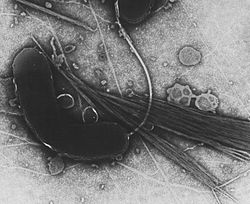Vibrio cholerae
| Vibrio cholerae | |
|---|---|

| |
| TEM image | |
| Scientific classification | |
| Kingdom: | |
| Phylum: | |
| Class: | Gamma Proteobacteria
|
| Order: | Vibrionales
|
| Family: | |
| Genus: | |
| Species: | V. cholerae
|
| Binomial name | |
| Vibrio cholerae Pacini 1854
| |
Vibrio cholerae(also Kommabacillus) is a gram negative comma-shaped bacterium with a polar flagellum that causes cholera in humans.[1][2] V. cholerae and other species of the genus Vibrio belong to the gamma subdivision of the Proteobacteria. There are two major biotypes of V. cholerae, classical and El Tor, and numerous serogroups.
V. cholerae was first isolated as the cause of cholera by Italian anatomist Filippo Pacini in 1854, but his discovery was not widely known until Robert Koch, working independently thirty years later, publicized the knowledge and the means of fighting the disease.[3][4]
Genomics and Evolution
The 4.0 Mbp genome of N16961, an O1 serogroup, (in America) El Tor biotype, 7th pandemic strain of V. cholerae, is composed of two circular chromosomes of unequal size that are predicted to encode a total of 3,885 genes[5]. The genomic sequence of this representative strain has furthered our understanding of the genetic and phenotypic diversity found within the species V. cholerae. Sequence data have been used to identify horizontally acquired sequences, dissect complex regulatory and signaling pathways, and develop computational approaches to predict patterns of gene expression and the presence of metabolic pathway components. Microarrays are being used to study the evolution of the organism. Genomic sequencing of additional strains, subtractive hybridization studies, and the introduction of new model systems have also contributed to the identification of novel sequences and pathogenic mechanisms associated with other strains.[2].
See also
References
- ^ Ryan KJ; Ray CG (editors) (2004). Sherris Medical Microbiology (4th ed. ed.). McGraw Hill. ISBN 0838585299.
{{cite book}}:|author=has generic name (help);|edition=has extra text (help)CS1 maint: multiple names: authors list (link) - ^ a b Faruque SM; Nair GB (editors). (2008). Vibrio cholerae: Genomics and Molecular Biology. Caister Academic Press. ISBN 978-1-904455-33-2 .
{{cite book}}:|author=has generic name (help)CS1 maint: multiple names: authors list (link) - ^ Bentivoglio M, Pacini P (1995). "Filippo Pacini: a determined observer". Brain Res. Bull. 38 (2): 161–5. doi:10.1016/0361-9230(95)00083-Q. PMID 7583342.
- ^ Howard-Jones N (1984). "Robert Koch and the cholera vibrio: a centenary". British medical journal (Clinical research ed.). 288 (6414): 379–81. doi:10.1136/bmj.288.6414.379. PMC 1444283. PMID 6419937.
- ^ Heidelberg, et al. (2000). DNA sequence of both chromosomes of the cholera pathogen Vibrio cholerae. Nature 406(6795):477-83
